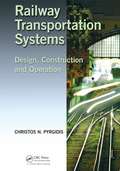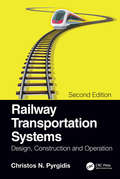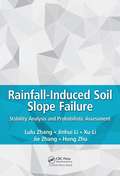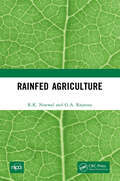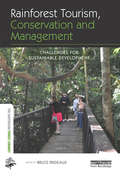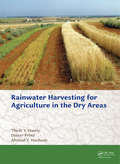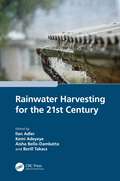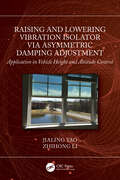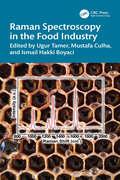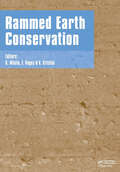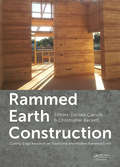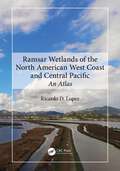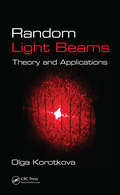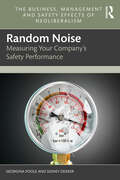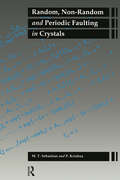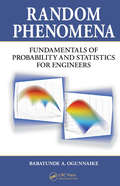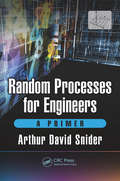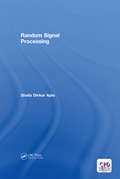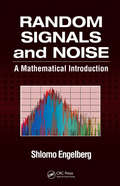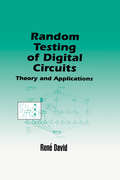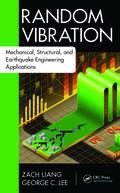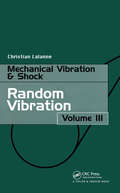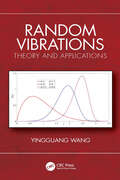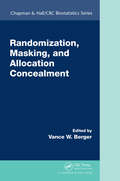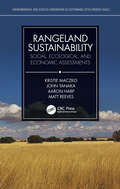- Table View
- List View
Railway Transportation Systems: Design, Construction and Operation
by Christos N. PyrgidisIncorporates More Than 25 Years of Research and ExperienceRailway Transportation Systems: Design, Construction and Operation presents a comprehensive overview of railway passenger and freight transport systems, from design through to construction and operation. It covers the range of railway passenger systems, from conventional and high speed inter
Railway Transportation Systems: Design, Construction and Operation
by Christos N. PyrgidisRailway Transportation Systems covers the entire range of railway passenger systems, from conventional and high-speed intercity systems to suburban, regional, operating on steep gradients, and urban ones. It also examines in depth freight railway systems transporting conventional loads, heavy loads, and dangerous goods. For each system, the text provides a definition; an overview of its evolution and examples of good practice; the main design, construction, and operational characteristics; and the preconditions for its selection. Additionally, it offers a general overview of safety, interfaces with the environment, forces acting on the track, and techniques that govern the stability and guidance of railway vehicles. This new edition brings two new chapters. One concerns pre-feasibility studies of urban rail projects, and the other analyses the operation of railway systems under specific weather conditions and natural phenomena. New material examines dilemmas, trends and innovations in rail freight transportation; a new definition for high-speed rail; a number of case studies; and an update of cutting-edge technologies. It is ideal for graduate students, engineers, consultants, manufacturers, and transport company executives who need a reference and guide.
Rainfall-Induced Soil Slope Failure: Stability Analysis and Probabilistic Assessment
by Jie Zhang Lulu Zhang Hong Zhu Xu Li Jinhui LiRainfall-induced landslides are common around the world. With global climate change, their frequency is increasing and the consequences are becoming greater. Previous studies assess them mostly from the perspective of a single discipline—correlating landslides with rainstorms, geomorphology and hydrology in order to establish a threshold prediction value for rainfall-induced landslides; analyzing the slope’s stability using a geomechanical approach; or assessing the risk from field records. Rainfall Induced Soil Slope Failure: Stability Analysis and Probabilistic Assessment integrates probabilistic approaches with the geotechnical modeling of slope failures under rainfall conditions with unsaturated soil. It covers theoretical models of rainfall infiltration and stability analysis, reliability analysis based on coupled hydro-mechanical modelling, stability of slopes with cracks, gravels and spatial heterogenous soils, and probabilistic model calibration based on measurement. It focuses on the uncertainties involved with rainfall-induced landslides and presents state-of-the art techniques and methods which characterize the uncertainties and quantify the probabilities and risk of rainfall-induced landslide hazards. Additionally, the authors cover: The failure mechanisms of rainfall-induced slope failure Commonly used infiltration and stability methods The infiltration and stability of natural soil slopes with cracks and colluvium materials Stability evaluation methods based on probabilistic approaches The effect of spatial variability on unsaturated soil slopes and more
Rainfed Agriculture
by R.K. Nanwal G.A. RajannaThis book discusses various issues related to Rainfed Agriculture, for example: Soil and water conservation Drought management strategies Rain-water harvesting Crops and cropping system for dryland agriculture Conservation agriculture Climate-smart agriculture and watershed management The subject matter is both narrative and critical, explained with illustrations and tables. This book is co-published with NIPA. Taylor and Francis does not sell or distribute its print and electronic editions in India, Pakistan, Nepal, Bhutan, Bangladesh and Sri Lanka.
Rainforest Tourism, Conservation and Management: Challenges for Sustainable Development (The Earthscan Forest Library)
by Bruce PrideauxGlobally rainforests are under threat on numerous fronts, including clearing for agriculture, harvesting for timber and urban expansion. Yet they have a crucial role in biodiversity conservation, climate change mitigation and providing other ecosystem services. As the term is used in this book, rainforests include both temperate and tropical, although the emphasis is on tropical rainforests. Rainforests are also attractive tourist spaces and where they have been used as a tourism resource have generated significant income for local communities. However not all use of rainforests as a tourism resource has been sustainable. This book argues that sustainability must be the foundation on which tourism use of this complex but ultimately fragile ecosystem must be built upon. It provides a multi-disciplinary perspective, incorporating rainforest science, management and tourism issues. The book is organized into four sections commencing with Rainforest Ecology and Management followed by People and Rainforests, Opportunities for Rainforest Tourism Development and finally Threats to Rainforests. Each major rainforest region is covered, including the Amazon, Central America, Africa, Australia and south-east Asia, in the context of a specific issue. For example rainforests in Papua New Guinea are examined in the context of community-based ecotourism development, while the rainforests in Borneo are discussed in an examination of wildlife issues. Other issues covered in this manner include governance, empowerment issues for rainforest peoples and climate change.
Rainwater Harvesting for Agriculture in the Dry Areas
by Theib Y. Oweis Dieter Prinz Ahmed Y. HachumDry areas suffer not only from limited rainfall but alsonatural leakage'-90% of rainwater is lost directly or indirectly, and is unavailable for agriculture or domestic use. Water harvesting is a low-cost, easy-to-use, environmentally-friendly way to recover a large part of this lost water. How does water harvesting work? Which sites or areas are
Rainwater Harvesting for the 21st Century
by Kemi Adeyeye Ilan Adler Aisha Bello-Dambatta Berill TakacsAccess to water in many parts of the world is increasingly challenging due to scarcity, quality issues and lack of access to adequate supply infrastructure. Currently, over 2 billion people around the world experience high water stress, and about 4 billion people experience severe water scarcity for at least one month on an annual basis. Rainwater harvesting (RWH) is increasingly seen as both an excellent alternative source of water and a valuable climate change adaptation measure. However, large-scale adoption remains challenging in many parts of the globe. This book, Rainwater Harvesting for the 21st Century, serves as a rigorous yet practical guide for a broad audience interested in the many opportunities that RWH systems can provide, including water and food security, flood management and climate change adaptation. It comprehensively covers the state of the art in RWH with practical examples of cutting-edge research and innovation in the design, operation and maintenance of RHW systems from both academics and practitioners. Highlights include: A comprehensive, transdisciplinary perspective of the latest advances in RWH techniques. Examples and case studies from around the world.
Raising and Lowering Vibration Isolator via Asymmetric Damping Adjustment: Application in Vehicle Height and Attitude Control
by Zhihong Li Jialing YaoThis book introduces an approach of controlling vehicle height and attitude by actively raising and lowering vibration isolators via asymmetric damping adjustment.The first section of this book identifies the theoretical foundation of asymmetric damping adjustment and discusses practical applications and the significance of this advancement. The second section discusses the mechanics and laws governing the active raising and lowering of the vibration isolator. The final two sections present the application of this method by incorporating a number of control strategies, including model predictive control, hybrid model predictive control, and active disturbance rejection control. The methodology is validated through simulation and co-simulation under various vehicle conditions.This book will be of interest to automotive engineers and those interested in the field of mechanics, vibration, and control.
Raman Spectroscopy in the Food Industry
by Ugur Tamer Mustafa Culha Ismail Hakki BoyaciRaman spectroscopy has become one of the most important techniques effectively applied to detect specific analytes and microorganisms in food samples. Raman Spectroscopy in the Food Industry provides a comprehensive overview of the current state of the art and future prospects of Raman spectroscopy in food analyses. Through in-depth chapters, the authors discuss the fundamental principles of Raman spectroscopy, its instrumentation, methodologies, and its diverse applications across various food matrices. Real-world case studies and practical examples underscore the transformative potential of Raman spectroscopy in reshaping our understanding, analysis, and innovation within the realm of food science.Featured topics included are as follows: Raman spectroscopy applications in food science and technology The unique property of Raman phenomena, along with the variations in signal modes The different food safety topics, such as toxins, biosafety, foodborne bacteria, and fermentation Machine-learning studies on Raman spectrosopy in food science As the editors, we are committed to providing a valuable resource that inspires further exploration and collaboration in harnessing the power of Raman spectroscopy for the advancement of food analyses. We sincerely hope that this book serves as a catalyst for pushing the boundaries of knowledge and driving innovation in this exciting field.
Rammed Earth Conservation
by C. Mileto V. Cristini F. VegasIncludes a free CD containing the full contents of the book.The rammed earth technique, in all its variants, is widespread all over the world. This enormously prevalent building technique harbours an important richness of varieties both in application and in materials used. Interventions on historical rammed earth buildings have also been carried o
Rammed Earth Construction: Cutting-Edge Research on Traditional and Modern Rammed Earth
by D. Ciancio C. BeckettRammed Earth Construction: Cutting-Edge Research on Traditional and Modern Rammed Earth is a collection of peer-reviewed papers presented at the First International Conference on Rammed Earth Construction (ICREC2015, University of Western Australia, Perth, Western Australia, 10-13 February 2015) by academics, engineers and rammed earth practitioner
Ramsar Wetlands of the North American West Coast and Central Pacific: An Atlas
by Ricardo D. LopezThis is the first comprehensive international atlas featuring all ecological services provided by Ramsar wetlands, with complete views of all Ramsar sites, through remote sensing and mapping. Written by an international expert on wetlands and remote sensing, this atlas is for a broad audience and compiles much-needed information on how the Ramsar wetlands are of significant value to the planet and society and can and should be managed in such a way that supports planetary sustainability. Focused on the 72 designated Ramsar sites along the western coasts of Alaska, Canada, California, Mexico, and the Central Pacific islands, each wetland is articulately documented with respect to its specific ecological functions and services.FEATURES Provides a comprehensive assessment of the key biophysical and societal elements of each Ramsar-designated wetland along the North American West Coast and Central Pacific Brings all designated Ramsar wetlands to the reader in one visually appealing compendium using geospatial technology Aids in highlighting the importance of and options for wetland conservation and restoration worldwide Explains the important role that wetlands play in environmental sustainability, directly supporting the global sustainable development goals of the United Nations Introduces the contributions of the Ramsar Convention on Wetlands to global conservation and restoration This atlas is intended for wetland managers and policymakers involved in the Ramsar Convention activities and for wetland ecologists and other allied environmental scientists and practitioners, such as hydrologists, microbiologists, and botanists. It is also a valuable resource for researchers, faculty, and graduate students affiliated with programs such as wetland ecology, wetland management, environmental studies, environmental management, and survey of wetlands.
Random Light Beams: Theory and Applications
by Olga KorotkovaRandom Light Beams: Theory and Applications contemplates the potential in harnessing random light. This book discusses light matter interactions, and concentrates on the various phenomena associated with beam-like fields. It explores natural and man-made light fields and gives an overview of recently introduced families of random light beams. It outlines mathematical tools for analysis, suggests schemes for realization, and discusses possible applications. The book introduces the essential concepts needed for a deeper understanding of the subject, discusses various classes of deterministic paraxial beams and examines random scalar beams. It highlights electromagnetic random beams and matters relating to generation, propagation in free space and various media, and discusses transmission through optical systems. It includes applications that benefit from the use of random beams, as well as the interaction of beams with deterministic optical systems.• Includes detailed mathematical description of different model sources and beams• Explores a wide range of man-made and natural media for beam interaction • Contains more than 100 illustrations on beam behavior• Offers information that is based on the scientific results of the last several years • Points to general methods for dealing with random beams, on the basis of which the readers can do independent researchIt gives examples of light propagation through the human eye, laser resonators, and negative phase materials. It discusses in detail propagation of random beams in random media, the scattering of random beams from collections of scatterers and thin random layers as well as the possible uses for these beams in imaging, tomography, and smart illumination.
Random Noise: Measuring Your Company's Safety Performance (The Business, Management and Safety Effects of Neoliberalism)
by Sidney Dekker Georgina PooleIn the realm of safety management, this book embarks on a profound exploration of how the political economy was reshaped in the last two decades. Much like privatization, deregulation, and financialization altered the economic landscape, this narrative unveils how safety management has been affected by the intertwined dynamics of asset underinvestment, privatization, self-regulation, workplace flexibilization, and market-driven policies.This book, the second installment of a thought-provoking trilogy on the consequences of neoliberalism, mirrors the political economy's promotion of the private sector's role in the economy. Just as neoliberalism amplified and accelerated the mechanisms of human-made disasters in complex systems, this narrative lays bare the heightened potential for safety misfortunes when governed by market-driven principles.As the story unfolds, the book delves into the concept of 'synoptic legibility' in safety management, akin to how the political economy distilled its essence into privatization and deregulation. The authors scrutinize the consequences of translating safety measures into rigid targets, unveiling how this shift can distort the integrity of safety metrics and inadvertently harm individuals. Drawing parallels with historical blunders such as England's window tax, the book contemplates the precarious nature of equating simplified metrics with safety achievements. Much like the political economy's 'acceptable risk' renegotiations, it examines how the pursuit of safety through metrics and surveillance can lead to 'manufactured insecurity,' eroding trust, autonomy, and professionalism.In Random Noise, Poole and Dekker extend this reach once again, writing for all managers, board members, organization leaders, consultants, practitioners, researchers, lecturers, students, and investigators curious to understand the genuine nature of organizational and safety performance.
Random Non-Random Periodic Fau
by M. T. Sebastian P. KrishnaThis book provides a comprehensive overview of stacking faults in crystal structures. Subjects covered include: notations used in representations of close-packed structures; types of faults; methods of detection and measurement such as X-ray diffraction, electron diffraction and other techniques; theoretical models of non-random faulting during phase transitions; specific examples of - close packed structures including, zinc sulphide, silicon carbide and silver iodide.
Random Phenomena: Fundamentals of Probability and Statistics for Engineers
by Babatunde A. OgunnaikeMany of the problems that engineers face involve randomly varying phenomena of one sort or another. However, if characterized properly, even such randomness and the resulting uncertainty are subject to rigorous mathematical analysis. Taking into account the uniquely multidisciplinary demands of 21st-century science and engineering, Random Phenomena
Random Processes for Engineers: A Primer
by Arthur David SniderThis book offers an intuitive approach to random processes and educates the reader on how to interpret and predict their behavior. Premised on the idea that new techniques are best introduced by specific, low-dimensional examples, the mathematical exposition is easier to comprehend and more enjoyable, and it motivates the subsequent generalizations. It distinguishes between the science of extracting statistical information from raw data--e.g., a time series about which nothing is known a priori--and that of analyzing specific statistical models, such as Bernoulli trials, Poisson queues, ARMA, and Markov processes. The former motivates the concepts of statistical spectral analysis (such as the Wiener-Khintchine theory), and the latter applies and interprets them in specific physical contexts. The formidable Kalman filter is introduced in a simple scalar context, where its basic strategy is transparent, and gradually extended to the full-blown iterative matrix form.
Random Signal Processing
by Shaila Dinkar ApteThis book covers random signals and random processes along with estimation of probability density function, estimation of energy spectral density and power spectral density. The properties of random processes and signal modelling are discussed with basic communication theory estimation and detection. MATLAB simulations are included for each concept with output of the program with case studies and project ideas. The chapters progressively introduce and explain the concepts of random signals and cover multiple applications for signal processing. The book is designed to cater to a wide audience starting from the undergraduates (electronics, electrical, instrumentation, computer, and telecommunication engineering) to the researchers working in the pertinent fields. <P><P> Key Features: <li>Aimed at random signal processing with parametric signal processing-using appropriate segment size. <li>Covers speech, image, medical images, EEG and ECG signal processing. <li> Reviews optimal detection and estimation. <li>Discusses parametric modeling and signal processing in transform domain. <li>Includes MATLAB codes and relevant exercises, case studies and solved examples including multiple choice questions
Random Signals and Noise: A Mathematical Introduction
by Shlomo EngelbergUnderstanding the nature of random signals and noise is critically important for detecting signals and for reducing and minimizing the effects of noise in applications such as communications and control systems. Outlining a variety of techniques and explaining when and how to use them, Random Signals and Noise: A Mathematical Introduction focuses on applications and practical problem solving rather than probability theory.A Firm FoundationBefore launching into the particulars of random signals and noise, the author outlines the elements of probability that are used throughout the book and includes an appendix on the relevant aspects of linear algebra. He offers a careful treatment of Lagrange multipliers and the Fourier transform, as well as the basics of stochastic processes, estimation, matched filtering, the Wiener-Khinchin theorem and its applications, the Schottky and Nyquist formulas, and physical sources of noise.Practical Tools for Modern ProblemsAlong with these traditional topics, the book includes a chapter devoted to spread spectrum techniques. It also demonstrates the use of MATLAB® for solving complicated problems in a short amount of time while still building a sound knowledge of the underlying principles.A self-contained primer for solving real problems, Random Signals and Noise presents a complete set of tools and offers guidance on their effective application.
Random Testing of Digital Circuits: Theory and Applications
by Rene David"Introduces a theory of random testing in digital circuits for the first time and offers practical guidance for the implementation of random pattern generators, signature analyzers design for random testability, and testing results. Contains several new and unpublished results. "
Random Vibration: Mechanical, Structural, and Earthquake Engineering Applications (Advances in Earthquake Engineering)
by Zach Liang George C. LeeFocuses on the Basic Methodologies Needed to Handle Random ProcessesAfter determining that most textbooks on random vibrations are mathematically intensive and often too difficult for students to fully digest in a single course, the authors of Random Vibration: Mechanical, Structural, and Earthquake Engineering Applications decided to revise the cu
Random Vibration: Random Vibration (Iste Ser. #Volume 3)
by Christi LalanneThe vast majority of vibrations Encountered in the real Environment are random in nature. Such vibrations are intrinsically complicated, and this volume describes the Enabling process for simplification of the analysis required. and the analysis of the signal in the frequency domain. Power spectrum density is also defined, with the requisite precautions to be taken in its calculation described together with the processes (windowing. overlapping) necessary for improved results. A further complementary method, the analysis of statistical properties of the time signal. is described. This enables the distribution law of the maxima of a random Gaussian signal to be determined and simplifies calculation of fatigue damage to be made by the avoidance of the direct counting of peaks.
Random Vibrations: Theory and Applications
by Yingguang WangRandom Vibrations: Theory and Applications investigates methods and theories involved in random vibration analyses of linear and nonlinear systems, as well as in predicting random vibration induced failures.This book is a lucid and well-paced introduction to random vibrations, superbly motivated and illustrated through a wealth of convincing applications in various engineering fields. The strong points of the book are its coverage of weakly stationary and ergodic random processes, spectral analysis of random processes, mode displacement superposition method, equivalent linearization technique for nonlinear random vibrations and an updated definition of rain flow cycle for fatigue analysis. Particularly appealing features of the book are its numerous examples and end-of-chapter exercises. This book offers a clear guide to the formulations and mathematical properties of random vibration analysis techniques, with an emphasis on practical applications rather than mathematical development for its own sake. However, some important mathematical formulas have been explicitly deduced in a detailed manner so that readers can go through the material in this book very smoothly and efficiently.This book is intended for upper undergraduate and graduate students who are interested in learning advanced techniques for performing random vibration analysis, researchers and scientists investigating linear and nonlinear systems under random external excitations, and aeronautical/civil/mechanical/structural/ocean engineers involved in the design and manufacture of real-world stochastically excited engineering systems.
Randomization, Masking, and Allocation Concealment (Chapman & Hall/CRC Biostatistics Series)
by Vance BergerRandomization, Masking, and Allocation Concealment is indispensable for any trial researcher who wants to use state of the art randomization methods, and also wants to be able to describe these methods correctly. <P><P>Far too often the subtle nuances that distinguish proper randomization from flawed randomization are completely ignored in trial reports that state only that randomization was used, with no additional information. Experience has shown that in many cases, the type of randomization that was used was flawed. It is only a matter of time before medical journals and regulatory agencies come to realize that we can no longer rely on (or publish) flawed trials, and that flawed randomization in and of itself disqualifies a trial from being robust or high quality, even if that trial is of high quality otherwise. <P><P>This book will help to clarify the role randomization plays in ensuring internal validity, and in drawing valid inferences from the data. The various chapters cover a variety of randomization methods, and are not limited to the most common (and most flawed) ones. Readers will come away with a profound understanding of what constitutes a valid randomization procedure, so that they can distinguish the valid from the flawed among not only existing methods but also methods yet to be developed.
Rangeland Sustainability: Social, Ecological, and Economic Assessments (Environmental and Societal Dimensions of Sustainable Development Goals)
by Kristie Maczko Aaron Harp John Tanaka Matt ReevesThis book provides an integrated description of the indicators of rangeland sustainability that capture ecological, economic, and social dimensions. It takes a fresh look at the information available on current and emerging issues across rangelands, and presents collaborative research for future progress. Authors offer a framework for evaluating rangeland sustainability, the best available data to use, as well as an interactive tool for use at a variety of geographical scales. Readers with limited knowledge of rangelands, as well as professional rangeland ecologists and land managers, will gain an understanding of the best tools available today to assess sustainability across rangeland ecosystems in the U.S.
